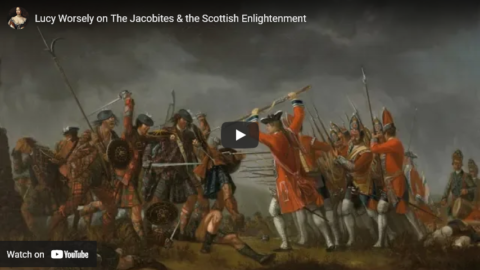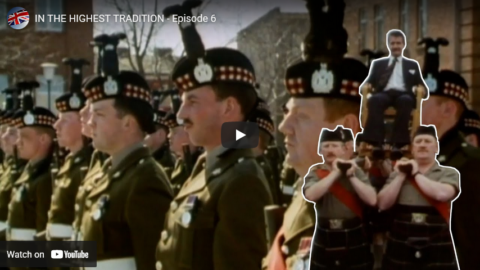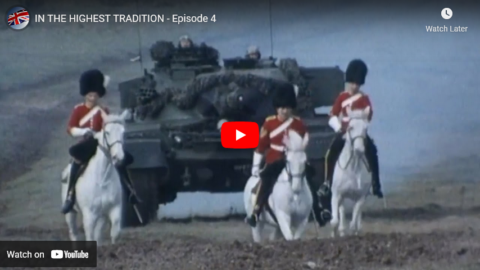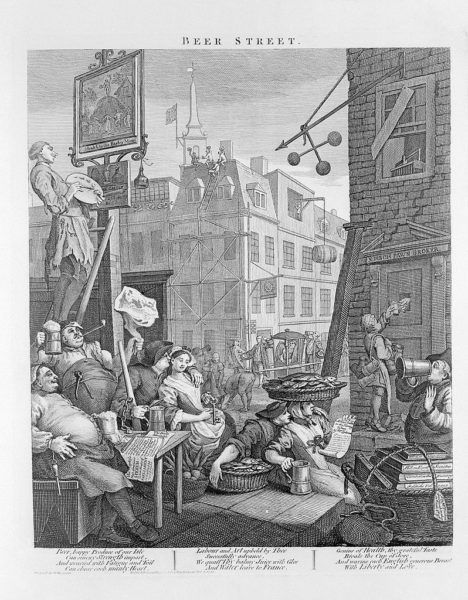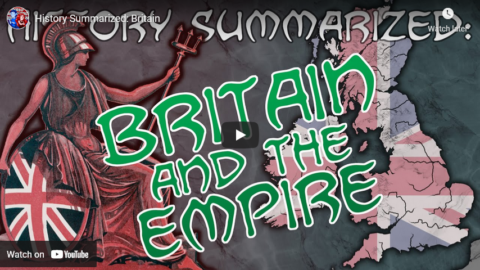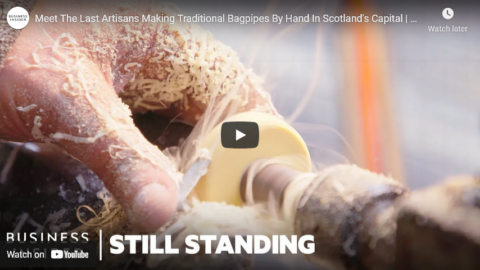Tasting History with Max Miller
Published 20 Sep 2022
(more…)
September 21, 2022
The Medieval Saint Diet
September 14, 2022
Whisky – Scotland’s Water of Life
Tasting History with Max Miller
Published 13 Sep 2022
September 6, 2022
Scotland’s AMAZING Jacobite Steam Train
Dylan’s Travel Reports
Published 4 Dec 2020An amazing day out on West Coast Railways’ iconic Jacobite steam train from Fort William to Mallaig and back, part of the stunning West Highland Line!
Date of Travel: 21 October 2020
Class of Travel: First Class
Rolling Stock: LMS Stanier Class 5 4-6-0/Mk1
Cost of Ticket: £133.75 ($176.10, €150; price for 2 people)
Origin: Fort William, United Kingdom (Scotland)
Destination: Mallaig, United Kingdom (Scotland)
*Currency conversions correct as of 09/11/2020 to nearest $/€0.05
(more…)
September 2, 2022
QotD: Historical parallels between the British and American empires
… let us compare the US imperial experience to its British model. A whimsical exercise in comparative dates.
England was colonised by the Norman Empire (a tribe that spread across France, Britain, Italy, and the Middle East can be referred to as an empire I believe), in 1066. After some initial fierce resistance, they settled well, integrated with the local economy, and started developing a more advanced economic society.
North America was colonised by the British Empire (and Spanish and French of course), in the sixteenth century. After some initial fierce resistance, they settled well, integrated with the local economy, and started developing a more advanced economic society.
Norman England spent the next few centuries gradually taking out its neighbours. Wales, Ireland, and eventually Scotland (though the fact that the Scottish King James I & VI actually inherited England confuses this concept a bit). The process was fairly violent.
The North American “English” colonies spent the next few centuries taking out their neighbours. Indian tribes, Dutch, Spanish and French colonists, etc. The process was fairly violent.
England fought a number of wars over peripheral areas, particularly the Hundred Years war over claims to lands in France.
The North American colonies enthusiastically joined (if not blatantly incited) the early world wars, with the desire of taking over nearby French and Spanish colonies
The English fought a civil war in the 1640s to 50s over the issue of how to share power between the executive government, the oligarchs, and the commons. It appears that the oligarchs incited the commons (which was not very common in those days anyway). It was extremely bloody, and those on the periphery — particularly the Scots and Irish — came out badly (and with a long term bad taste for their over-mighty neighbour).
The Colonies fought their first civil war over the issue of how to share power between the executive, the oligarchs and the commons in the 1770s to 80s. It is clear that the oligarchs incited the commons (who in the US were still not very common — every male except those Yellow, Red or Black. An improvement? Certainly not considering the theoretical philosophical base of the so-called Revolution!). It was not really so bloody, but those on the periphery — particularly the Indians and slaves (both of which were pro-British), and the Loyalists and Canadians — came out badly. (60-100,000 “citizens” were expelled or forced to flee for being “loyalists”, let alone Indians and ex-slaves). Naturally the Canadians and their new refugee citizens developed a long term bad taste for their over-mighty neighbour — who attempted to attack them at the drop of a hat thereafter.
The British spent the next century and a half accumulating bits of empire — the Dominions, the Crown Colonies, and the Protectorates — in a haphazard fashion. Usually, but not always, troops followed traders and settlers.
The United States spent the next century and a half accumulating bits of empire — conquests from the Indians, purchases from France and Russia, conquests from Mexico and Spain, annexations of places like Hawaii, etc. — in a haphazard fashion. Usually, but not always, troops followed traders and settlers.
Nigel Davies, “The Empires of Britain and the United States – Toying with Historical Analogy”, rethinking history, 2009-01-10.
May 15, 2022
The young man who might have been King Henry IX of England
In the latest Age of Invention newsletter, Anton Howes considers what might have been had the eldest son of King James I and VI lived to take the thrones of England and Scotland:
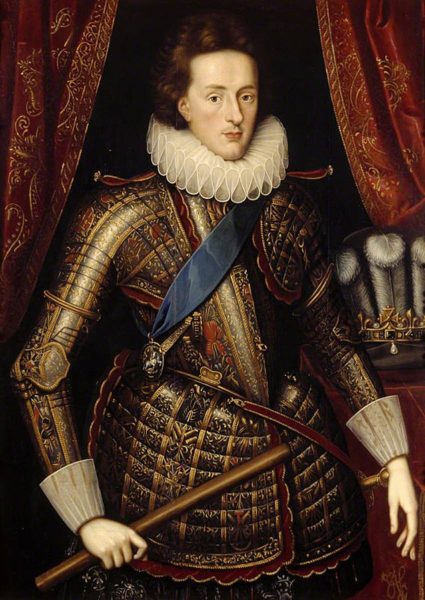
Portrait of Prince Henry Frederick (1594-1612), Prince of Wales by Isaac Oliver
National Trust, Dunster Castle; http://www.artuk.org/artworks/prince-henry-frederick-15941612-prince-of-wales-99804 via Wikimedia Commons.
Henry Frederick, Prince of Wales, was the eldest son and heir of James I of England. He would presumably have become Henry IX had he managed to outlive his father. But he died in 1612 aged just 18. The kingdom instead ended up with his younger brother Charles I and civil war. I’m not sure how far Prince Henry was influenced, but it seems that many of the major innovators of the period were purposefully cultivating him as a kind of inventor-scientist king.
It reminds me of a very similar and successful scheme, which I noticed when researching my first book on the history of the Society for the Encouragement of Arts, Manufactures and Commerce. This was the scheme to cultivate George III — famed for his madness and losing the Thirteen Colonies, but also for his collection of scientific instruments and interest in agricultural innovation. Those interests were no accident: his upbringing had included lessons in botany from the inventor Stephen Hales, in art and architecture from William Chambers, and in mathematics from George Lewis Scott. These were not just experts, but active innovator-organisers. Hales was a key founder of the Society of Arts; Chambers helped organise the artists who split off from it to form the Royal Academy of Arts; and Scott was involved in updating Ephraim Chambers’s Cyclopaedia, or Universal Dictionary of Arts and Sciences — an early encyclopaedia focused on technical knowledge. And their efforts bore fruit. Unlike his predecessor and grandfather George II — whose interests mainly fell under the headings of Handel, Hanover, hunting, and heavy women — George III became an active patron of science, invention, and the arts.
Given how successfully the inventors cultivated George III, it makes me wonder how things might have looked had Prince Henry lived to be king. His younger brother Charles I had an education heavily geared towards languages, theology, and overcoming various health issues through sports. But Henry — naturally athletic and charismatic — had an upbringing tightly controlled by Sir Thomas Chaloner, who had a major financial stake in innovation.
Chaloner housed and supported his alchemist cousin (also, confusingly, called Thomas Chaloner). This cousin had published an early treatise on the medical applications of saltpetre, or nitre (what we now call potassium nitrate), and had tried to produce alum on the isle of Lambay, off the coast of Ireland. Alum was a valuable substance used to fix cloth dyes, which had hitherto been monopolised by the Pope, who owned Europe’s only alum mine. Opening a competing, English-controlled, Protestant supply of alum was not just about starting a new industry. It was a matter of Europe-wide religious and strategic urgency.
[…]
Henry’s circle also included the Dutch polymath Cornelis Drebbel, who would become famous all over Europe for travelling in a submarine under the Thames, for his improvements to microscopes, and for inventing a perpetual motion machine (which isn’t as silly as it sounds — it was effectively a kind of barometer, exploiting changes in temperature and air pressure to move).
And that’s just the tip of the iceberg. The more I look into the circle of inventors around Prince Henry, the more familiar names crop up. There even seems to be some connection to Simon Sturtevant, one of the original patentees of a method to make iron by using coal instead of wood — Chaloner was seemingly responsible for evaluating Sturtevant’s inventiveness, to see if he merited a patent. I found it very striking that when Sturtevant’s iron-making business was about to get going, Prince Henry was to have a share.
Given such innovative company, we can only imagine what kind of a king Prince Henry might have been. If George III grew up to be “Farmer George”, might a Henry IX have become associated with navigation or hydraulic engines? We’ll never know. But even during his brief lifetime, there was plenty of patronage to be had for inventors at the court of their would-be Inventor-King.
April 22, 2022
Lucy Worsely on The Jacobites & the Scottish Enlightenment
Whitehall Moll History Clips
Published 22 Jul 2018A segment on the Jacobites and the Scottish Enlightenment that blossomed in the face of Hanoverian oppression.
March 23, 2022
In The Highest Tradition — Episode 6
British Army Documentaries
Published 9 Nov 2021This is the final part of the six-part series which delves into the world of the British Army’s regimental traditions and the stories behind them. This is a world where a Napoleonic Drum Major’s staff remains prized booty, a dog wears campaign medals awarded at Queen Victoria’s command, and snuff is served from a ram called George.
© 1989
This production is for viewing purposes only and should not be reproduced without prior consent.
This film is part of a comprehensive collection of contemporary Military Training programmes and supporting documentation including scripts, storyboards and cue sheets.
All material is stored and archived. World War II and post-war material along with all original film material are held by the Imperial War Museum Film and Video Archive.
March 15, 2022
In The Highest Tradition — Episode 5
British Army Documentaries
Published 4 Nov 2021The fifth in the series, this episode features stories about the Grenadier Guards, the favourite tipple of the Queen’s Lancashire Regiment, and how the King’s Own Scottish Borderers made porridge palatable.
© 1989
This production is for viewing purposes only and should not be reproduced without prior consent.
This film is part of a comprehensive collection of contemporary Military Training programmes and supporting documentation including scripts, storyboards and cue sheets.
All material is stored and archived. World War II and post-war material along with all original film material are held by the Imperial War Museum Film and Video Archive.
March 7, 2022
In The Highest Tradition — Episode 4
British Army Documentaries
Published 30 Oct 2021The fourth in a six-part series that delves into the world of regimental tradition. It looks at the illustrious history of the Royal Scots Greys with an account of how a French Imperial Eagle was won at Waterloo, and covers the tragic events of the Charge of the Light Brigade, the origins of the Victoria Cross, and follows the transition from horse to the tank.
© 1989
This production is for viewing purposes only and should not be reproduced without prior consent.
This film is part of a comprehensive collection of contemporary Military Training programmes and supporting documentation including scripts, storyboards and cue sheets.
All material is stored and archived. World War II and post-war material along with all original film material are held by the Imperial War Museum Film and Video Archive.
February 15, 2022
King James I and his court favourites
In the latest Age of Invention newsletter, Anton Howes continues the tale of King James I of England (also King James VI of Scotland at the same time, the crowns still being legally separate) and his use of favourites to help him avoid going back to Parliament to ask for money:
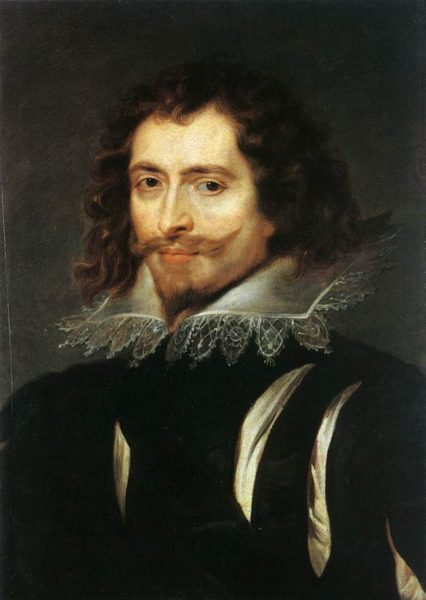
Portrait of George Villiers, First Duke of Buckingham, 1625.
Oil painting by Peter Paul Rubens (1577-1640) via Wikimedia Commons.
At the same time, James found a way to filter many of the petitions before they even reached him. This was something he already did in his original kingdom, Scotland, occasionally sending a noble “favourite” — like his kinsmen the duke of Lennox and the marquess of Hamilton — to dispense patronage and manage its parliament. Yet he increasingly, and even scandalously, relied on favourites in England too.
Using a favourite could make some sense from a political standpoint. Favourites often owed everything they had in terms of wealth, protection, titles and standing to the king personally. As creatures of the king, their loyalty was assured. They served an important practical function by dispensing patronage and absorbing pesky petitions, and could insulate the king himself from blame. Should the king make a mistake, his favourite was the obvious man to take the fall.
But for James, the use of favourites went beyond mere practicality, if they were ever practical at all. His interest could also be romantic.
Although James was married with kids, his favourite by 1607 was one Robert Kerr, the younger son of a minor Scottish laird. A mere groom of the bedchamber, about twenty years James’s junior, he had fallen from his horse in a jousting accident and broken his leg. The king helped nurse him back to health, and was soon besotted. Kerr — often anglicised to Carr — was very rapidly given money, titles, and lands. Within a year he had been knighted, after four years made a viscount, and in 1613 an earl.
But what had been so rapidly gained, could be just as rapidly lost. In 1614, a rival faction at court made sure that another, even younger and more attractive man would catch the king’s eye. This was George Villiers, the 22-year-old younger son of an obscure knight. With his “effeminate and curious” hands and face, as well as a remarkable physique — a clergyman, later a bishop, marvelled at his “well compacted” limbs — Villiers’s rise made Kerr’s seem slow. Every year brought him a new title: in 1615 Villiers was made a knight, 1616 a viscount, 1617 an earl, and 1618 a marquess — a very rare title in England, last given to an influential co-regent of Edward VI, and before that to Anne Boleyn so that she could marry king Henry VIII.
Eventually, incredibly, in 1623 James made Villiers a duke. This was a title that was typically reserved for members of the royal family, or else given by very powerful regents to themselves — Villiers was the first in neither of those categories to be made a duke in 140 years. And he hadn’t even been born into the nobility! The apparent lesson: working on your triceps can really, really pay off.
Yet Villiers had more than just an angelic face and muscles. He seems to have had a real talent for politics, very quickly asserting independence from the faction that had put him before the king. And he would somehow remain the favourite even after James died and was succeeded by his heterosexual son, Charles I. In the dangerous waters of courtly faction — Robert Kerr had meanwhile been found guilty of murder and was imprisoned in the Tower — Villiers knew how to keep himself afloat, and even to chart a course of his own.
And he was extraordinarily corrupt.
December 31, 2021
Hogmanay Shortbread from 1779
Tasting History with Max Miller
Published 28 Dec 2021Use my exclusive link here https://cen.yt/TastingHistory5 to get $15 off your first three bags.
Support the Channel with Patreon ► https://www.patreon.com/tastinghistory
Merch ► crowdmade.com/collections/tastinghistory
Instagram ► https://www.instagram.com/tastinghist…
Twitter ► https://twitter.com/TastingHistory1
Tiktok ► TastingHistory
Reddit ► r/TastingHistory
Discord ► https://discord.gg/d7nbEpy
Amazon Wish List ► https://amzn.to/3i0mwGtSend mail to:
Tasting History
PO Box 766
Burbank, CA 91503LINKS TO SOURCES**
Cookery, and Pastry, as Taught and Practised by Mrs Maciver by Susanna Maciver: https://amzn.to/3EmSPcm
The Little Book of Hogmanay by Bob Pegg: https://amzn.to/30RAmqO**Some of the links and other products that appear on this video are from companies which Tasting History will earn an affiliate commission or referral bonus. Each purchase made from these links will help to support this channel with no additional cost to you. The content in this video is accurate as of the posting date. Some of the offers mentioned may no longer be available.
Subtitles: Jose Mendoza | IG @ worldagainstjose
PHOTO CREDITS
Shortbread fingers: Dave Souza – Own work, CC BY-SA 2.5, https://commons.wikimedia.org/w/index…
Black Bun: IMBJR, CC BY-SA 3.0 https://creativecommons.org/licenses/…, via Wikimedia CommonsMUSIC CREDIT
“Achaidh Cheide – Celtic” by Kevin MacLeod is licensed under a Creative Commons Attribution 4.0 license. https://creativecommons.org/licenses/…
Source: http://incompetech.com/music/royalty-…
Artist: http://incompetech.com/#tastinghistory #hogmanay #shortbread
December 30, 2021
HogmaNO! Scottish government warns Scots not to cross the border to celebrate Hogmanay
In Scotland, one of the traditions of the winter is Hogmanay (spelled umpteen different ways), the last day of the old year, but Scottish public health and government officials are trying to keep the Scots away from the English border this year:
Scots have been urged not to travel to England for new year celebrations to get around the more stringent Covid-19 restrictions north of the border.
There is no travel ban currently in place to stop people going to England, where nightclubs are still open.
But Deputy First Minister John Swinney said doing so would go against the “spirit” of Scottish Covid-19 measures.
He said travelling would be “the wrong course of action” due to the “serious situation” with the Omicron variant.
Case numbers in Scotland hit “alarming” record highs over Christmas and Boxing Day, with the faster-spreading strain now accounting for the majority of all infections.
First Minister Nicola Sturgeon — who is to update MSPs in a virtual sitting of the Scottish Parliament on Wednesday afternoon — said she expected the figures to rise even more in the days ahead.
Scots have been encouraged to stay at home as much as possible, and to limit any social gatherings to no more than three households.
Large events such as Edinburgh’s traditional Hogmanay street party have been cancelled, with extra curbs in hospitality settings and nightclubs shut down entirely.
Clubs remain open south of the border, where no new restrictions are being imposed, but Mr Swinney told BBC Breakfast that he would “discourage” anyone from travelling to England to see in the new year.
He said: “People are free to make their own judgments. But what we have got recognise is that Omicron is a serious threat to absolutely everybody within our society and we have all got to take measures to protect ourselves by limiting our social contacts and connections and by complying with the restrictions we have in place.
Despite the Scottish government’s warnings, English pubs along the (currently) undefended border are expecting over a hundred thousand thirsty Scots to invade on the 31st:
English border pubs are expecting upwards of 100,000 Scottish and Welsh revellers to cross into England on New Year’s Eve amid mounting anger at Nicola Sturgeon and Mark Drakeford for cracking down on festivities.
December 10, 2021
History Summarized: Britain and the Empire
Overly Sarcastic Productions
Published 20 Aug 2021How is it that the history of some islands off the northern coast of Europe balloons into a worldwide history? Empire is how! Let’s dig into the history of Britain since Union of the Crowns of England and Scotland in 1603, and follow that narrative through the monumental rise and precipitous fall of the British Empire.
Special thanks to the community members on Discord who assisted me with my script: Corvin the Crow, Johnny, Jdedredhed, Joud, Jéuname, Klieg, RileyTheProcrastinator, The Missing Link, and thesleepingmeerkat
SOURCES & Further Reading: The Great Courses Lecture series Foundations of Western Civilization II: A History of the Modern Western World by Robert Buchols lectures 11, 12, 13, 14, 15, 18, 19, 20, 21, 22, 30, The History Of England volumes 3 Rebellion, 4 Revolution & 5 Dominion by Peter Ackroyd, Scotland: A Concise History by Fitzroy MacLean, The Great Cities in History by John Julius Norwich, A Concise History of Wales by Geraint H. Jenkins, Sea Power: The History and Geopolitics of the World’s Oceans by James Stavridis.
Our content is intended for teenage audiences and up.
PATREON: https://www.Patreon.com/OSP
PODCAST: https://overlysarcasticpodcast.transi…
DISCORD: https://discord.gg/osp
MERCH LINKS: http://rdbl.co/osp
OUR WEBSITE: https://www.OverlySarcasticProductions.com
Find us on Twitter https://www.Twitter.com/OSPYouTube
Find us on Reddit https://www.Reddit.com/r/OSP/
December 4, 2021
When King James VI became King James I and VI
In his latest Age of Invention newsletter, Anton Howes discusses how the King of Scotland succeeded to the English throne as well:
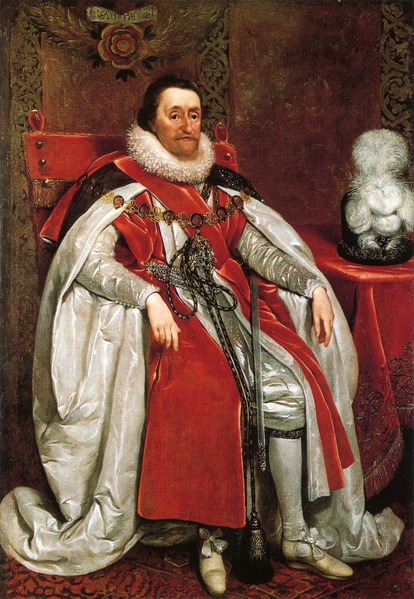
King James I (of England) and VI (of Scotland)
Portrait by Daniel Myrtens, 1621 from the National Portrait Gallery via Wikimedia Commons.
It’s late March 1603, and an exhausted messenger arrives in Edinburgh bearing a sapphire ring. He has ridden for over two days straight, over hundreds of miles, and his hair and clothes are matted with blood — on the way he had fallen from his horse, a hoof striking him directly in the head. It’s a miracle he’s alive, but he knows it has been worth it. He is the very first to tell you that your childless first cousin twice removed — the killer of your mother, whom you never knew — is finally dead. You, King James VI of Scotland, are James I of England as well.
[…]
James’s accession was a frenzy. From the very moment of Elizabeth’s death, her entire patronage network was turned on its head. Her chief ministers, the Privy Council, were relatively safe. Some of them had been corresponding with James for years. But they could only look on, anxiously, as a rush of would-be cronies went north to meet their new king. The exhausted messenger with the sapphire ring, Sir Robert Carey, was just the first. Carey had been related to Elizabeth I on her mother’s side — he was her first cousin once removed. (Carey’s grandmother was the “other Boleyn girl”, played by Scarlett Johansson in the 2008 film — although there’s no solid evidence, it’s not totally impossible that Carey was actually related to Elizabeth on her father’s side instead …) But that family connection meant nothing now that the queen was dead.
The sudden reset of the source of all patronage meant that the earlier the access to the new king’s person, the greater the chance of gaining his favour. Carey may have angered the Privy Council by riding ahead of their formal letters to James, but his exertion won him an on-the-spot appointment as a gentleman of the bedchamber, and his wife became a lady in waiting to James’s queen. The Careys were soon charged with the care of the royal couple’s younger sickly child, and when that child eventually became Charles I, Carey was made Earl of Monmouth. Not a bad result for a head wound and a two days’ ride, though I’m sure the horses would disagree. An old proverb about England was that it was “a paradise for women, a purgatory for servants, and a hell for horses” — something that James’s accession really put to the test. One teenage noblewoman reported how she and her mother killed three horses in a single day, pushing them hard despite the heat, in their rush to meet the new queen.
Just as courtiers flocked to James, however, the king wanted to win friends and allies too. So he handed out favours like confetti. Before he had even reigned a single year, he had created 934 knighthoods — already more than the 878 that Elizabeth I, her generals, and her lord deputies in Ireland had created over the course of her entire 45-year reign. One morning, during his journey down to London, James knighted more people than Elizabeth had in her first five years — all before he’d even had his breakfast. The sheer volume of new knighthoods prompted Francis Bacon — one of about 300 to be knighted in London ahead of the coronation — to call it a “divulged and almost prostitute title”.
The same went for peerages. Elizabeth, over her long reign of almost half a century, had created only 18 new titles. James, before he had even been crowned, had already created 12 — mostly turning knights into lords, and raising some lords into earls. Along with the honours came grants of land, annual pensions, and one-off gifts — not only to James’s new English courtiers, but to his old Scottish favourites too. James’s arrival was an explosion of largesse. (Not all were happy about the relative loss of favour, of course […] at least one pro-invention courtier got involved in a treasonous plot against the new king and ended up losing his head.)
James’s largesse even extended to policy. As he triumphantly marched into London, he issued a proclamation to immediately suspend all of Elizabeth’s patent monopolies, to be re-granted pending review. (This did not apply to patents for trading corporations or guilds.) Rather than leaving the validity of patents to be tested in the common-law courts, at great legal cost to those affected, he would have his Privy Council systematically examine them first, only allowing them if they were in the public interest. He characterised it as a continuation — even a “perfecting” — of Elizabeth’s partial measures a couple of years earlier, which we discussed in Part II. With his proclamation also condemning various other unpopular things, like high court fees, his new subjects were overjoyed.
But the honeymoon was not to last.
November 20, 2021
Meet The Last Artisans Making Traditional Bagpipes By Hand In Scotland’s Capital | Still Standing
Business Insider
Published 2 Jul 2021Bagpipes have been a symbol of Scottish heritage for centuries, but traditional artisans have faced stiff competition with the rise of mass manufacturing. Kilberry Bagpipes is now the last workshop in the capital city of Edinburgh where they still make them by hand.
For more information, visit:
https://kilberrybagpipes.com/——————————————————
#Bagpipes #Scotland #BusinessInsider
Business Insider tells you all you need to know about business, finance, tech, retail, and more.
Visit us at: https://www.businessinsider.com
BI on Instagram: https://read.bi/2Q2D29T
BI on Twitter: https://read.bi/2xCnzGF
BI on Amazon Prime: http://read.bi/PrimeVideoMeet The Last Artisans Making Traditional Bagpipes By Hand In Scotland’s Capital | Still Standing
From the comments:
Kilberry Bagpipes
1 month ago
It was a pleasure having you guys in to film with us! Thank you for putting together such a fantastic video illustrating what we do and why we do it! If anyone has any further questions or is keen to learn to play then please feel free to email us where we will be happy to help!All the best,
Dave and Ruari
The Kilberry Team

